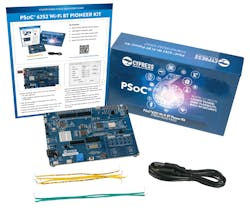Bluetooth: The Great Configurator
What you’ll learn
- What is Matter?
- What is Bluetooth being used for?
- Why configuration matters.
To start with, Matter is supported by the Connectivity Standards Alliance. Matter is probably the worst name they could come up with because you can’t find anything about it using the search engines, but nonetheless it’s becoming the Rosetta Stone of IoT.
Matter is designed to unify disparate networks that are employed in IoT applications like smart-home and smart-office environments and the growing industrial IoT (IIoT) environment. There are a multitude of protocols and communication links from Wi-Fi to 5G to 802.15.4. IPv6 tends to be a common low-level protocol, but it takes more than a simple connection to make devices play together. Trying to get a light switch on one network to turn on a light connected to another network isn’t as easy as it sounds. Matter is designed to address that situation.
An in-depth look at Matter will have to wait, though, as this article looks at how devices are being added to networks. Once connected to a network, the management through platforms like Matter come into play. However, getting them there is often accomplished using Bluetooth and a smartphone app. This affects how devices are designed because they need to support Bluetooth and often another wireless protocol like Wi-Fi, Zigbee, or Z-Wave.
Security and Connecting Via Bluetooth
Luckily, most networks these days are designed to run, and even are initially configured to work with, encryption for connectivity and often for data transport. Way back when, a Wi-Fi router/access point would start up with no encryption enabled. Now there’s usually a device-specific username and password on the device, and accessing the wireless network requires an additional password.
Connecting a device like a smart TV is something that can often be done in a standalone mode, because it’s obviously equipped with a display. A remote-control device can be used along with the user interface to connect to a Wi-Fi network that has password protection.
This isn’t the case for many IoT devices, which often lack everything short of a way to provide power. Sometimes they even include a status LED.
So how does one connect these devices that are devoid of a built-in user interface? Answer: Use a smartphone app connected to the device via Bluetooth.
Typically, a security handshake occurs. The smartphone often uses its camera to scan a QR code that can provide all sorts of information from the smartphone app to download to a secure password associated with the device being configured.
Bluetooth can be used as the device’s main connectivity mode, but it lacks many of the features of other alternatives, from increased range to higher throughput to even low power consumption—and Bluetooth isn’t a power hog. As a result, the device typically must employ two wireless interfaces: Bluetooth and something else.
Dual-Mode Wireless SoCs
In the case of Infineon’s AIROC CYW30739, the two wireless interfaces are Bluetooth Low Energy (BLE) and 802.15.4. The latter supports protocols like Thread that works with Matter as well as other open and proprietary wireless mesh networks.
Another is Infineon’s CYW43012 Wi-Fi + Bluetooth Combo Chip, which is found in the CY8CKIT0 PSoC Pioneer Kit (Fig. 1). The kit includes a PSoC 62 Line host microcontroller with a 150-MHz Cortex-M4 and a 100-MHz Cortex-M0. Also on-board is an Excelon very-low-power F-RAM.
The wireless support is provided by Murata’s 1LV Module with Wi-Fi and Bluetooth support (Fig. 2). This multi-die module has its own shield and includes the CYW43012 chip.
The systems are supported by Infineon’s ModusToolbox. They also support the open-source Mbed OS developed by Arm. Of course, Matter support is part of the mix, too.
Infineon isn’t alone in delivering dual-mode wireless SoCs and many protocols still lack this combination. Likewise, there are other ways to tie in a new device to a wireless network, such as using the connection to the network to let it know what new device is being added.



